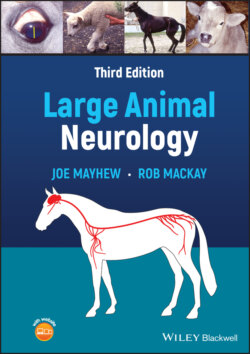Читать книгу Large Animal Neurology - Joe Mayhew - Страница 41
Glossopharyngeal nerve—CN IX; vagus nerve—CN X; accessory nerve—CN XI
ОглавлениеA major function of these cranial nerves is achieved through innervation of the pharynx and larynx with both sensory and motor fibers. This is tested by listening for normal laryngeal sounds, observing normal swallowing of food and water, assessing the swallowing reflex by passage of an esophageal tube, and finally by inspection of the larynx and pharynx manually and preferably with the aid of an endoscope. The major centers for control of the pharynx and larynx via these three cranial nerves are the nucleus ambiguus and nucleus solitarius in the caudal medulla oblongata. The most important clinical signs of dysfunction are related to paralysis of the pharynx and larynx, and the severity of signs depends on whether there is unilateral or bilateral involvement. In pharyngeal paralysis, usually food, water, and saliva can be seen at the nostrils in horses, and at the nostrils and mouth in ruminants, and spilling onto the floor. During exercise, unilateral paralysis of the larynx results in an abnormal respiratory noise—so‐called roaring in physically active horses, but is usually subclinical in sedentary animals. Stertorous breathing may be detected with diseases that cause bilateral pharyngeal or laryngeal paralysis.
In the horse at least, the thoraco‐laryngeal adductor response, or slap test (Figure 2.12), should be performed.26 The skin just caudal to the dorsal aspect of the scapula is slapped firmly with a hand while the horse is exhaling, and while the larynx is observed with an endoscope, the normal response being brief adduction of the contralateral arytenoid cartilage. Contraction of the contralateral dorsal and lateral laryngeal musculature over the muscular process of the arytenoid cartilage can also be palpated with the fingers while the withers are slapped. This has been detected in cooperative foals as early as 2 weeks of age. Usually, this response can be felt externally as a slight tap or muscular contractions under the fingers. The afferent pathway is through the segmental dorsal thoracic nerves to the spinal cord, cranially in the contralateral cervical spinal cord white matter, and thus to the contralateral vagal motor nucleus in the medulla oblongata. From there, the efferent pathway is through the contralateral vagus nerve to the cranial thorax and then back up the neck in the recurrent laryngeal nerve to the larynx. The reflex can be interrupted at any of these sites.
Figure 2.12 Pathway for the thoracolaryngeal response test.
Lesions in the nucleus ambiguus and in the swallowing center of the medulla oblongata usually affect adjacent structures causing degrees of somnolence, ataxia, weakness, and signs of involvement of other cranial nerve nuclei. Many severe, diffuse brain diseases can result in dysphagia without lesions in the medulla oblongata, which is the result of interference with the voluntary central motor neuronal control of swallowing. Because of their close association with the guttural pouch, CNs IX, X and XI can be involved with guttural pouch diseases. Finally, dysphagia is seen with diseases affecting pharyngeal muscles as well as the diffuse neuromuscular paralysis of botulism and the hypertonicity of tetanus.
Most tall horses over 1.6 m (16 hands) have a palpable asymmetry to the laryngeal musculature, irrespective of whether they have an asymmetric thoracolaryngeal reflex or make abnormal respiratory noises during exercise. This finding, along with results of testing the thoracolaryngeal reflex, therefore needs to be interpreted cautiously; a negative right‐to‐left test result being of no real additional clinical value in such patients.
